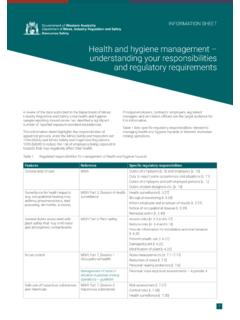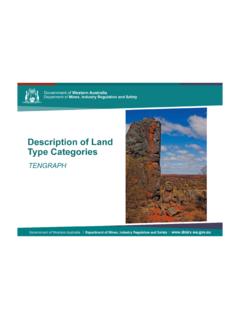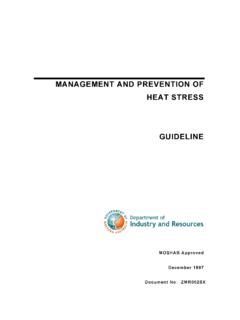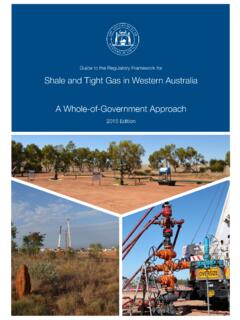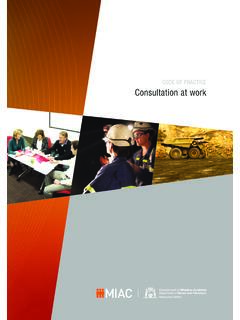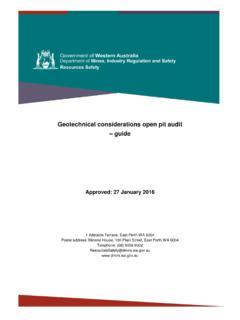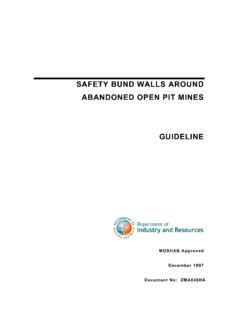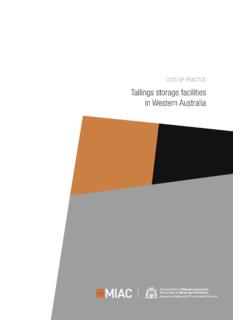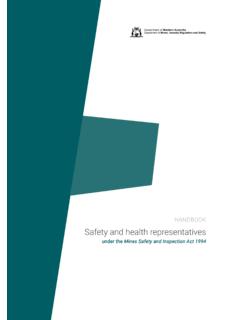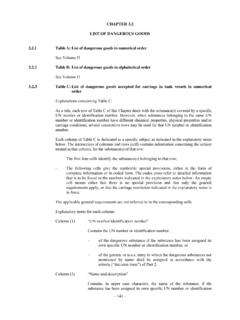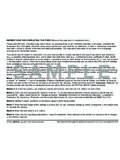Transcription of Dangerous Goods Safety (Storage and Handling of Non ...
1 Government of Western Australia Department of Mines, Industry Regulation and Safety GUIDE. Dangerous Goods Safety ( storage and Handling of Non-explosives) Regulations 2007. Government of Western Australia Department of Mines, Industry Regulation and Safety GUIDE. Dangerous Goods Safety ( storage and Handling of Non-explosives) Regulations 2007. Disclaimer The information contained in this publication is provided in good faith and believed to be reliable and accurate at the time of publication. However, the information is provided on the basis that the reader will be solely responsible for assessing the information and its veracity and usefulness. The State shall in no way be liable, in negligence or howsoever, for any loss sustained or incurred by anyone relying on the information, even if such information is or turns out to be wrong, incomplete, out-of-date or misleading. In this disclaimer: State means the State of Western Australia and includes every Minister, agent, agency, department, statutory body corporate and instrumentality thereof and each employee or agent of any of them.
2 Information includes information, data, representations, advice, statements and opinions, expressly or implied set out in this publication. Loss includes loss, damage, liability, cost, expense, illness and injury (including death). The State of Western Australia supports and encourages the dissemination and exchange of Reference its information. The copyright in this publication is licensed under a Creative Commons Department of Mines, Industry Regulation and Safety , Attribution International (CC BY) licence. 2019, Dangerous Goods Safety ( storage and Handling of Non-explosives) Regulations 2007: Department of Mines, Industry Regulation and Safety , Western Australia, 59 pp. ISBN 978 1 922149 71 8 (web). State of Western Australia (Department of Mines, Under this licence, with the exception of the Industry Regulation and Safety ) 2019 Government of Western Australia Coat of Arms, the Department's logo, any material This publication is available on request in other formats protected by a trade mark or licence and where for people with special needs.
3 Otherwise noted, you are free, without having to seek our permission, to use this publication in Further details of Safety publications can be obtained by accordance with the licence terms. contacting: We also request that you observe and retain Safety Regulation Group Regulatory Support any copyright or related notices that may Department of Mines, Industry Regulation and Safety accompany this material as part of the 100 Plain Street attribution. This is also a requirement of the EAST PERTH WA 6004 Creative Commons Licences. Telephone: +61 8 9358 8001 For more information on this licence, visit NRS: 13 36 77. legalcode Email: II. Contents Dangerous Goods Safety ( storage and Handling of Non-explosives) Regulations 1. Dangerous Goods Safety ( storage and Handling of Non-explosives) Regulations I. Foreword ..VI. Part 1 When does this guide apply?..1. 1 2. What is a Dangerous Goods site?.. 2.
4 What Goods are Dangerous Goods ?.. 2. What is the difference between Dangerous Goods and hazardous chemicals?.. 2. What is a placarding and manifest quantity of Dangerous Goods ?.. 5. When does this guide not apply?.. 6. Part 2 Duties and 2 Duties of 8. Manufacturers and 8. Site 9. All persons on a Dangerous Goods Persons at 3 Site licence and other Sites to be Dangerous Goods site licencing Other approvals and licences under the Part 3 Risk and Safety 4 Managing Risk Dangerous Goods management system ..19. Change System Part 4 Design and operation of storage and Handling 5 Dangerous Goods in 6 Segregation from other Separation 7 Chemical 8 Impact 9 Ignition sources and hazardous General risk control Risk control measures for hazardous 10 Hazardous Mechanical ventilation ..29. Local exhaust Natural Dangerous Goods Safety ( storage and Handling of Non-explosives) Regulations 2007 guide III. 11 Containing Spill containment for viscous Spill control for vertical tanks installed prior to 12 Bulk Installation and 13 Underground Ammonium nitrate (AN) and AN emulsions (ANE) in underground Fuel in underground 14 Underground fuel tank Leak detection and 15 16 17 Site 18 Unsupervised 19 Timing and reducing Decommissioning of underground petroleum storages (UPS).
5 40. Waste Risks of not decommissioning Part 5 Transit storage and 20 Managing risk during transfer General risk reduction Personal Safety for transfer 21 Filling Filling elevated Fill connection with manifold for filling multiple 22 Flammable liquid 23 Dangerous Goods in transit and storage Part 6 Emergency 25 Fire ..49. Fire Fire control 26 Risk control equipment and Personal protective equipment (PPE)..50. Safety showers, eye and face IV Dangerous Goods Safety ( storage and Handling of Non-explosives) Regulations 2007 guide 27 Emergencies: plans, response, reporting, reports and Emergency Contents and specific incident Adjacent Fire emergency services emergency response guide (FES-ERG)..54. Incident response and reporting requirements ..54. Appendix 1 Legislative Appendix 2 Appendix 3 Glossary of Appendix 4 Dangerous Goods Safety ( storage and Handling of Non-explosives) Regulations 2007 guide V.
6 Foreword The Act approved code is not mandatory, it is expected that deviations from recommended practice will be justified A key focus of the Dangerous Goods Safety Act 2004 using a risk management approach, and it can be (the Act) is the duty to minimise risk from Dangerous demonstrated that the use of alternative risk control Goods . measures provides an equivalent or lower level of risk. The duty to minimise risk not only applies to employers and employees but to all persons, including members Scope and application of the public. This duty is placed on everyone involved with Dangerous Goods and goes beyond the workplace This guide provides practical guidance on how duties of the Occupational Safety and Health Act 1984 to comply with the regulations for persons who and the Mines Safety and Inspection Act 1994. manufacture, import, supply, store or handle Dangerous Goods and all persons at Dangerous Goods sites.
7 This guide also applies to major hazard facilities (MHFs). Regulations which have additional duties under the Dangerous Goods Safety (Major Hazard Facilities) Regulations The Act is supported by the Dangerous Goods Safety 2007 (the MHF Regulations). ( storage and Handling of Non-explosives) Regulations 2007 (the regulations). It is essential to understand A glossary of terms and abbreviations used in this guide and comply with this legislation and adopt a risk are given in Appendices 3 and 4. management approach using all relevant codes and standards. How to use this guide The regulations are enforceable and breaches may result in licence suspension, prosecution, or directions In providing guidance, the word should' is used in this to cease operations and undertake remedial action. guide to indicate a recommended course of action, while may' is used to indicate an optional course of Due to the inherently high hazards of Dangerous Goods action.
8 The words must', requires' or mandatory'. to people, property and the environment (heat, fire, indicate that a legal requirement exists that must be toxicity, explosion and corrosion) the regulations include complied with. Examples in this guide are normative specific Dangerous Goods Safety measures that must and form an integral part of this guide. be implemented. This guide provides a general overview of regulatory An important part of these requirements relate to requirements and should be used in conjunction with emergency services and emergency response. To specific codes of practice that deal with particular have internationally recognized Safety advice that subject matters. This guide also includes various is consistent from site to site improves safe and references to provisions of the Act, regulations and appropriate emergency response and greatly assists mandatory codes of practice which set out legal off-site emergency response personnel.
9 Examples of requirements. These references are not exhaustive and emergency response measures include emergency this guide should be read in conjunction with the Act plans, DFES Emergency Response Guide (FES-ERG), and regulations. Dangerous Goods placarding, site plans, signage, Dangerous Goods manifest, SDS, ensuring safe access, This guide also refers to other approved codes of and onsite emergency response materials. practice which provide specific and detailed technical instructions on dealing with regulatory requirements and Australian Standards that deal with hazardous Codes of practice areas or various classes or mixed classes of Dangerous Goods . Approved codes of practice provide Safety recommendations to assist people in meeting their Though every effort has been made this guide cannot obligations under the Act and regulations. The codes cover every possibility. Persons who have duties under are approved and gazetted by the Minister under the Act and associated regulations should conduct a section 20 of the Act, and may be used as a defence in specific review of their operations (risk assessment).
10 Law (under section 62 of the Act). and consult with competent persons to determine what further measures may be necessary or desirable These codes are not intended to prevent innovative for the safe storage and Handling of Dangerous Safety practice or use of equipment that improves Goods , considering good work practices and local Safety performance. Although compliance with an circumstances. VI Dangerous Goods Safety ( storage and Handling of Non-explosives) Regulations 2007 guide PART 1. WHEN DOES THIS GUIDE. APPLY? 1. 1 Introduction What is a Dangerous Goods site? What is the difference between A Dangerous Goods site is a place where Dangerous Dangerous Goods and hazardous Goods are, or are intended to be, stored or handled. chemicals? Rural Dangerous Goods locations and small quantity Dangerous Goods are classified on the basis of Dangerous Goods locations are not considered immediate physical or chemical effects, such as: Dangerous Goods sites under the regulations.
